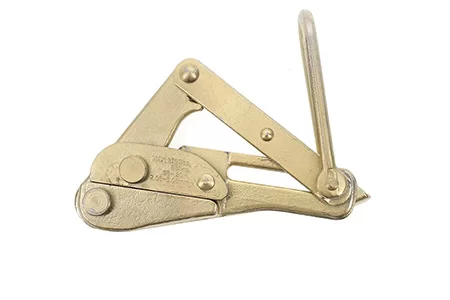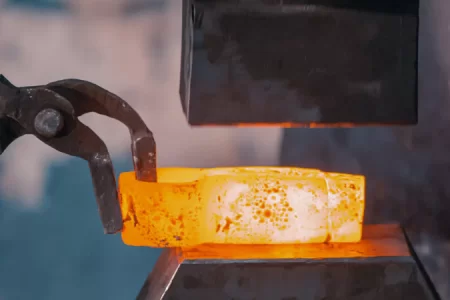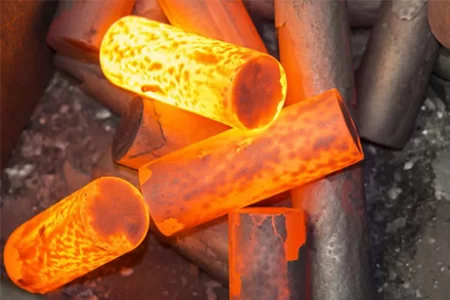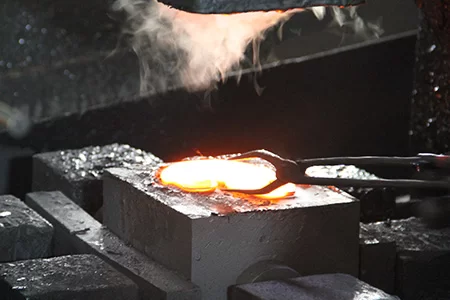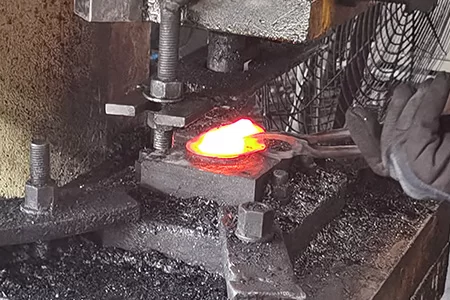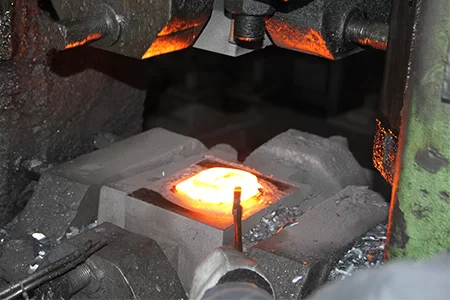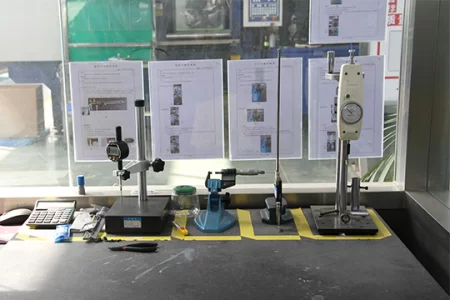By sharing knowledge, experience and views in the field of forging technology, we help you understand, learn and apply relevant technologies.

Hulk Metal Forging Technology
Share technical experience
-
Home>
-
Blog>
-
Technology>
Hot Forged Lifting Hooks: Manufacturing Process, Performance Advantages and Industry Applications of High-Strength Lifting Hooks

Lifting hooks are key components in the lifting and hoisting system, and their safety directly affects the stability and efficiency of the entire lifting operation. Whether in construction sites, port terminals, or in mining and petrochemical industries, lifting hooks play an irreplaceable role. In order to ensure that these hooks have sufficient strength, toughness, and durability, scientific and reasonable processes must be adopted in the manufacturing process.
At present, the manufacturing methods of lifting hooks on the market mainly include hot forging, casting) and cold forging. Among them, the hot forging process has become the preferred method for manufacturing high-strength lifting hooks due to its excellent mechanical properties, good internal organizational structure, and higher durability. This article will discuss in detail the manufacturing process, performance advantages, quality control, market demand and future development trends of hot forged lifting hooks to help industry users have a deep understanding of the product and provide a professional reference for purchasing decisions.
Function and Application of Lifting Hooks
Definition and Function of Lifting Hooks
Lifting hooks are a kind of lifting device used for lifting and handling heavy objects, usually used in conjunction with lifting rigging such as wire ropes, chains, and lifting rings. Its core function is to connect lifting equipment and objects to be lifted so as to achieve efficient and safe operation in various lifting operations.
Lifting hooks are usually made of high-strength alloy steel to withstand large tensile forces, bending stresses, and impact loads. In order to improve the safety of use, different types of lifting hooks are usually designed with safety locks or other locking devices to prevent accidental falling off during lifting.
Application Fields of Lifting Hooks
Lifting hooks have a wide range of applications, covering almost all industries involving heavy object handling and lifting, including but not limited to:
·Construction engineering: used for lifting and transportation of building materials such as reinforced concrete components, steel structures, and prefabricated panels.
·Port terminals: used for lifting operations of containers, bulk cargo, and large equipment to improve loading and unloading efficiency.
·Mining: used for lifting operations of heavy equipment such as mining machinery and equipment, ore transport vehicles.
·Petrochemical: used for lifting and installation of refineries, drilling platforms, and pipeline equipment.
·Machinery manufacturing: used for handling and assembly of large mechanical parts and metal components.
With the continuous advancement of global infrastructure construction, the demand for lifting hooks continues to grow, and its manufacturing quality directly affects the safety and operating efficiency of the entire industry. Therefore, it is crucial to choose high-quality hot forged lifting hooks.
The manufacturing process of hot forged lifting hooks
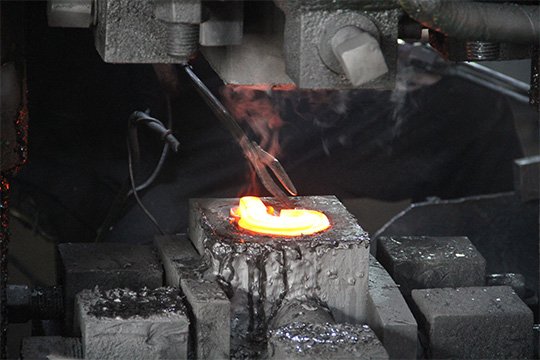
In order to ensure the quality of lifting hooks, the hot forging production process needs to go through multiple strict process steps. Each link directly affects the performance, load-bearing capacity, and service life of the product. The following is a detailed manufacturing process of hot-forged lifting hooks.
Material selection
The choice of material is the primary factor affecting the quality of hot-forged lifting hooks. Different application scenarios require different materials to meet the load-bearing requirements and working environment conditions. Usually, hot forged lifting hooks use the following common materials:
42CrMo alloy steel: This material has high strength and high toughness, and is an ideal choice for manufacturing lifting hooks for high load and heavy lifting operations. 42CrMo steel has good tensile strength, fatigue strength, and wear resistance, and is suitable for environments with high safety requirements for lifting operations, such as heavy machinery lifting, mining, and other scenarios.
35CrMo steel: This material has excellent impact resistance and is suitable for dynamic load environments. 35CrMo steel has superior fatigue resistance and impact toughness, so it is very common in heavy lifting operations such as construction sites and port loading and unloading where it needs to withstand severe impact or impact load changes.
C45 carbon steel: This material has a relatively low cost and is suitable for medium-intensity lifting operations. C45 steel has good strength and is suitable for some lifting occasions that do not require excessively high load-bearing capacity, such as the handling of small and medium-sized mechanical equipment.
The material selection of lifting hooks needs to be reasonably configured according to different working conditions, environmental requirements, and budgets to ensure the safety and efficiency of lifting operations.
Heating stage
The heating stage is a crucial step in the hot forging process. By controlling the heating temperature and heating method of the steel, it can be ensured that the metal material has sufficient plasticity for forging and achieves the ideal mechanical properties.
Temperature range: Usually, the temperature of the material of the lifting hooks is controlled between 1100 and 1250°C during heating. This temperature range ensures the plastic deformation ability of the steel and avoids local overheating or overcooling of the material during the forging process. Too high a temperature may cause the grain growth of the steel and affect the later mechanical properties, while too low a temperature may cause forging difficulties and affect the fluidity of the metal.
Heating equipment: Induction heating furnaces or gas furnaces are usually used in the heating stage. During the heating process, by controlling the temperature and heating time in the furnace, each billet is ensured to be heated evenly, avoiding local overheating or uneven cooling, thereby ensuring the overall quality of the metal during the forging process. Induction furnaces are usually more efficient and can better control the temperature and process of heating, while gas furnaces are suitable for large-scale production and can handle large-sized billets.
Forging
Once the steel is heated to the appropriate temperature, it can enter the forging stage. In this stage, the metal will undergo severe plastic deformation, and the metal billet will be gradually shaped into the final shape of the lifting hooks by applying external force.
Heat treatment process
The heat treatment process is an indispensable part of the forging process. The heat-treated lifting hooks can have better hardness, toughness, and wear resistance, thereby extending the service life and improving product performance.
Quenching + tempering: Forged lifting hooks usually need to be quenched and tempered. The quenching process heats the hot forging to the austenitizing temperature (usually between 850-900°C) and then cools it rapidly to harden the metal. Tempering is to heat the quenched metal again to a lower temperature and keep it for a certain period of time to reduce internal stress and improve toughness. Quenching + tempering treatment greatly improves the hardness of lifting hooks, which can meet the needs of high-intensity lifting work.
Normalizing treatment: Normalizing treatment is to heat the metal at a certain temperature to make it completely austenitized, and then air cool it. This process helps to refine the metal grains and improve the internal structure of the material, thereby improving its toughness and impact resistance. Normalizing treatment is particularly important for lifting hooks that bear dynamic loads.
Finishing and quality inspection
Finishing and quality inspection are important steps to ensure that the lifting hooks finally meet the use standards. Whether it is appearance accuracy, dimensional accuracy, or mechanical property testing, strict control is required.
Machining deburring: There are often certain burrs and oxide scales on the surface of the lifting hooks after hot forging, so they need to be removed by machining. This can not only improve the surface quality of the lifting hooks, but also reduce the potential damage caused by burrs during use.
Nondestructive testing: Nondestructive testing (NDT) techniques, such as ultrasonic testing (UT) and magnetic particle testing (MT), are used to detect internal defects in lifting hooks. Ultrasonic testing detects cracks and pores inside metals by emitting high-frequency sound waves, while magnetic particle testing detects surface and near-surface defects through a combination of magnetic fields and fine magnetic particles. These nondestructive testing methods can effectively ensure the internal quality of lifting hooks and avoid potential safety hazards.
Tensile test: Tensile test is used to verify the load capacity of lifting hooks. By simulating the lifting load in actual use, the load-bearing capacity of lifting hooks is measured and it is ensured that it can safely lift objects of a predetermined weight. This test is an important part of the quality inspection of lifting hooks to ensure that the product will not be damaged or deformed during lifting operations.
Performance advantages of hot-forged lifting hooks
Mechanical properties
Hot-forged lifting hooks have significant advantages in mechanical properties, especially in strength and impact resistance. First of all, the hot forging process can greatly improve the tensile strength of lifting hooks, usually by 30%-50%. This advantage makes hot forged lifting hooks have a stronger load-bearing capacity than cast products, can withstand greater loads, and adapt to higher-intensity working environments. This is crucial for lifting operations in the industrial and construction fields, because the objects in these environments are usually heavy and irregular in shape, and often encounter severe vibrations and shocks during handling.
In addition, the impact resistance of hot forged lifting hooks far exceeds that of cast products. By forging the metal at high temperatures, the internal structure of the material is optimized, the organization is denser and more uniform, and defects such as pores and shrinkage cavities that may occur during the casting process are avoided. This improvement significantly improves the impact resistance of lifting hooks, enabling them to maintain stable performance in complex working environments. For example, in high-risk places such as mining or ship lifting, hot forged lifting hooks can withstand greater impact forces without being prone to cracks or damage, thereby reducing equipment downtime and maintenance costs.
Structural integrity
The structural integrity of hot-forged lifting hooks is also a highlight of its performance. Compared with cast products, hot-forged lifting hooks have almost no internal defects such as pores and shrinkage holes. Through the forging process, the metal material undergoes plastic deformation at high temperatures, making its internal structure denser, eliminating the accumulation of gas and impurities, and ensuring higher structural density and stronger durability. This dense structure not only improves the strength of the lifting hook but also enhances its corrosion and wear resistance.
During the hot forging process, the grain structure of the metal will also change, and the grains will be refined. This process greatly improves the fatigue resistance of the metal. The fine grain structure makes the metal less likely to crack under repeated stress, thereby greatly extending the service life of the lifting hooks. Lifting hooks that have been hot-forged are particularly suitable for working under high-frequency use and heavy load conditions. They can continue to maintain efficient lifting performance, reduce frequent replacement and maintenance, and reduce long-term operating costs.
Quality Control and Inspection
In order to ensure that the quality of hot-forged lifting hooks meets strict usage standards, a series of quality inspections are required during the production process. Common inspection methods include:
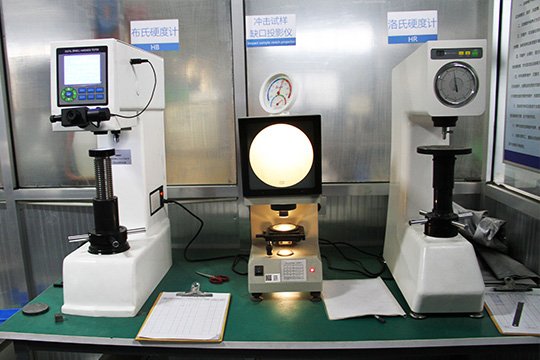
Ultrasonic flaw detection (UT)
Ultrasonic flaw detection technology uses high-frequency sound waves to detect defects inside the material, such as cracks, pores, etc. In this way, it is possible to effectively check whether there are tiny structural problems inside the hot-forged lifting hooks to ensure the integrity of its overall structure. This non-destructive inspection method can not only be carried out during the production process but also be regularly inspected after the product is delivered to ensure safe use.
Magnetic particle testing (MT)
Magnetic particle testing is a method used to detect surface cracks and surface defects on metals. By applying a magnetic field to the metal surface and covering it with magnetic powder, surface cracks, and other defects can be quickly found. This method is particularly suitable for lifting hooks with extremely high surface quality requirements, because surface defects may lead to reduced strength or even failure. Using magnetic particle testing can ensure that each product meets high standards of safety requirements before leaving the factory.
Hardness testing (HRC)
Hardness is an important indicator for measuring the compressive and wear resistance of metal materials. Through hardness testing, it can be ensured that the material hardness of the lifting hooks meets the design requirements, thereby ensuring its performance under high-load working conditions. Through hardness testing, the hot-forged lifting hooks can be accurately controlled in quality to ensure that they can withstand the pressure and impact in the working environment.
Hot-forged lifting hooks dominate the lifting industry with their excellent strength, toughness, and reliability. As an industry-leading hot-forged manufacturer, HULK Metal is able to provide high-quality, strictly tested lifting hooks to provide customers with safe and efficient lifting solutions.
Article Navigation
Article Navigation
Industries
Foundries
-

December.11, 2024
Analysis of the characteristics and main uses of wire grip for conductor
READ MORE
-

July.01, 2024
Difference between hot forging and cold forging
READ MORE
-

June.27, 2024
What are the advantages and disadvantages of the hot forging process?
READ MORE
-

February.28, 2025
Open Die Forging: Exploring the forging process and the key factors in selecting a OEM
READ MORE
-

February.24, 2025
Key Considerations for Closed Die Forging
READ MORE
-

February.18, 2025
Factors to consider when purchasing custom forgings
READ MORE
-

February.14, 2025
HULK Metal's hot forging quality control
READ MORE



